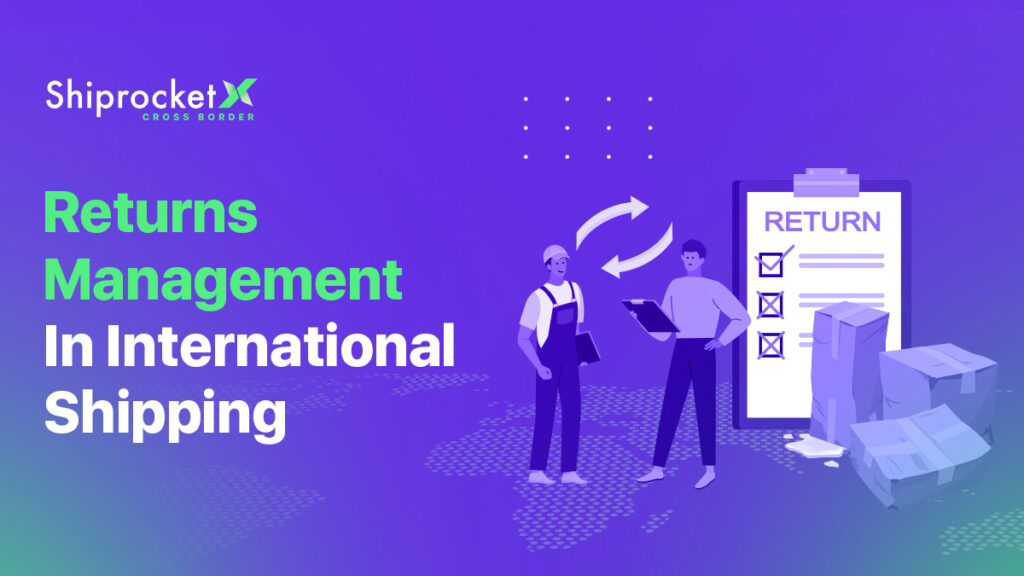Table of Contentshide

Returns management in international shipping refers to the process of handling and managing product returns in cross-border transactions. It involves various activities such as return authorisation, transportation, customs clearance, inspection, and final disposition of returned items.
Efficient returns management ensures that customers have a positive experience when dealing with product returns. By offering a hassle-free and well-managed return process, exporters can enhance customer satisfaction and maintain a good reputation. Satisfied customers are more likely to become repeat buyers and recommend the exporter to others.
Effective returns management can be a source of competitive advantage. Exporters that have streamlined returns processes and offer flexible return policies are often preferred by customers over competitors who have complex or inconvenient return procedures. This can help attract and retain customers in the highly competitive export market.
Exporters face certain risks associated with product returns, such as damaged or defective goods, incorrect orders, or customer dissatisfaction. By implementing robust returns management practices, exporters can minimize these risks. Timely identification and resolution of return issues can prevent further complications and potential financial losses.
Returns can be costly for exporters, involving expenses such as shipping, handling, restocking, and potential refunds. Effective returns management helps control these costs by optimizing processes, minimizing return volumes through improved product quality, and reducing unnecessary returns due to clearer product descriptions or accurate order fulfillment.
Returns management is closely linked to the overall supply chain. By efficiently handling returns, exporters can improve inventory accuracy, minimize stockouts, and optimize product flows. This leads to better supply chain visibility, reduced operational disruptions, and improved overall efficiency.
Returns management provides valuable data and insights about the reasons behind product returns. Analyzing return data can help identify patterns, root causes, and areas for improvement in product quality, packaging, shipping, or customer service. This data-driven approach allows exporters to make informed decisions to address recurring issues and prevent future returns.

An essential step in the returns management process is obtaining return authorisation from the seller or the e-commerce platform. This ensures that the return is valid and authorised.
Clear and well-defined return policies are crucial for both sellers and customers. International sellers should establish comprehensive return policies that cover aspects such as return timeframes, condition of returned goods, refund or exchange options, and any associated fees.
The transportation of returned items involves choosing the appropriate shipping method, carrier, and service level. Factors like cost, transit time, and reliability should be considered. It’s important to ensure that the return shipment complies with any applicable international shipping regulations.
International returns require customs clearance in both the country of origin and the destination country. Documentation such as commercial invoices, customs forms, and return labels may be required. The seller or logistics provider should be knowledgeable about the customs regulations of each country involved.
International returns must comply with various regulations, such as those related to hazardous materials, restricted items, or specific product categories. Sellers must ensure compliance to avoid penalties and delays.
In some cases, duties and taxes paid on the original shipment may be eligible for refund or credit when the goods are returned. However, this depends on the customs regulations of the specific countries involved. Sellers should be aware of these regulations to facilitate the return process.
Upon receiving the returned items, a thorough inspection should be conducted to verify their condition and determine the appropriate disposition. Depending on the condition, returned products may be restocked, repaired, refurbished, recycled, or disposed of.
Effective communication with customers throughout the returns process is crucial. Clear and prompt communication helps manage customer expectations, resolves issues and ensures a positive customer experience.
Reverse logistics refers to the logistics activities involved in handling returns. It includes coordinating the movement of goods, managing inventory, and optimising the flow of returned products. Efficient reverse logistics can reduce costs and improve customer satisfaction.
Returns management provides valuable data that can be analysed to identify patterns, reasons for returns, and areas for improvement. Analysing return data helps optimise inventory management, product quality, and customer satisfaction.
Returns management in international shipping can be complex due to the involvement of multiple parties, customs procedures, and logistical challenges. It requires careful planning, effective communication, and a robust logistics network to handle returns efficiently and maintain customer satisfaction. Fortunately, cross-border logistics aggregators like Shiprocket X help you meet the objective. If there are return orders placed after your product reached the destination country, your products are stored in the foreign warehouse and picked up for any next order you receive.

Post Disclaimer
The information provided in our posts or blogs are for educational and informative purposes only. We do not guarantee the accuracy, completeness or suitability of the information. We do not provide financial or investment advice. Readers should always seek professional advice before making any financial or investment decisions based on the information provided in our content. We will not be held responsible for any losses, damages or consequences that may arise from relying on the information provided in our content.



